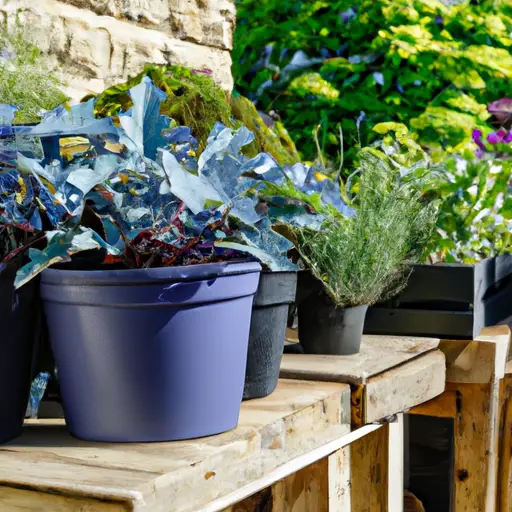Elevating Outdoor Spaces with Containers: Design Tips for Garden Enthusiasts
Container gardening has gained immense popularity over the years, and for good reason. Not only does it allow garden enthusiasts to bring their passion for plants to small spaces, but it also provides them with endless possibilities to elevate their outdoor areas. Whether you have a sprawling backyard or a tiny balcony, containers can transform any space into a lush oasis. In this article, we will delve into the world of container gardening and provide you with some design tips to create stunning outdoor spaces that will leave your neighbors green with envy.
1. Choosing the Right Containers
Before diving into the exciting world of plant selection and arrangement, it is crucial to choose the right containers. The choice of containers can make or break your outdoor space’s overall aesthetic appeal. When selecting containers, consider the style and theme you want to achieve in your garden. For a modern look, opt for sleek and minimalist containers made of materials like metal or fiberglass. If you prefer a more rustic vibe, terracotta or wooden containers can add warmth and charm to your garden.
Furthermore, ensure that the size of the container is appropriate for the plants you intend to grow. Larger containers offer more room for root growth and retain moisture better than smaller pots, making them ideal for plants that require more space and water.
2. Selecting Plants
Once you have chosen your desired containers, it’s time to pick the perfect plants that will thrive in them. When it comes to selecting plants for container gardens, consider their growth habits, light requirements, and compatibility with each other.
Firstly, determine whether you want to focus on flowering plants or foliage-centric arrangements. Mixing both can create a visually appealing contrast in your outdoor space. Consider using bold-colored flowers such as geraniums or petunias as focal points while pairing them with complementary foliage plants like hostas or ferns.
Secondly, take into account the light conditions in your garden. Some plants thrive in full sun, while others prefer shade or partial shade. Ensure that the plants you choose are well-suited to the available light, as this will greatly impact their health and growth.
Lastly, consider the compatibility of plants in terms of their water and nutrient requirements. Grouping plants with similar needs together will make watering and fertilizing more efficient, simplifying maintenance for you.
3. Create Depth with Height
To truly elevate your outdoor space, it’s important to create depth and dimension. One effective way to achieve this is by incorporating plants with varying heights into your container garden. Tall plants like ornamental grasses or cannas can be placed at the back or center of the arrangement, providing a vertical element. Medium-height plants like salvias or asters can be placed in the middle to add visual interest and bridge the gap between tall and short plants. Finally, low-growing plants like creeping thyme or succulents can be placed at the front to complete the layered effect.
Additionally, don’t forget about adding vertical elements beyond just plant height. Trellises or obelisks can provide support for climbing vines such as clematis or jasmine, adding another dimension to your container garden.
4. Pay Attention to Color Palette
A well-thought-out color scheme can make a significant impact on your container garden’s overall aesthetic appeal. Start by determining whether you want a harmonious, monochromatic look or a vibrant display of contrasting colors.
For a harmonious look, stick to one color family but include varying shades and textures within that range. This creates a soothing and cohesive visual experience. Monochromatic gardens work particularly well when paired with modern containers and clean lines.
On the other hand, if you prefer an eye-catching display of contrasting colors, go for complementary hues on opposite ends of the color wheel. For instance, pair purple flowers with yellow or orange foliage to create a striking visual contrast. Mixing warm and cool colors in your container garden can create a vibrant and lively atmosphere.
5. Consider Seasonal Plantings
Container gardens provide the opportunity to switch up your outdoor space’s look throughout the year by incorporating seasonal plantings. Embrace the changing seasons by selecting plants that thrive in different weather conditions, ensuring your garden remains vibrant and fresh all year round.
In spring and summer, consider including vibrant annuals like marigolds or zinnias for a burst of color. In fall, opt for plants with golden leaves like Japanese maple or ornamental grasses to evoke an autumnal feel. Finally, winter-friendly plants such as holly or conifers can add greenery and create an inviting atmosphere during the colder months.
Remember to plan ahead and leave room for seasonal plantings when designing your container arrangements. This way, you can effortlessly transition between different looks as the seasons change.
Conclusion
Container gardening is a versatile and creative way to elevate outdoor spaces. By carefully selecting containers, choosing suitable plants, creating depth with heights, paying attention to color palettes, and considering seasonal plantings, garden enthusiasts can transform even the smallest spaces into delightful retreats. So unleash your creativity and get ready to design stunning container gardens that will enhance the beauty of your outdoor areas all year round!













